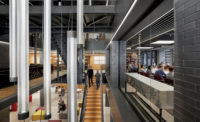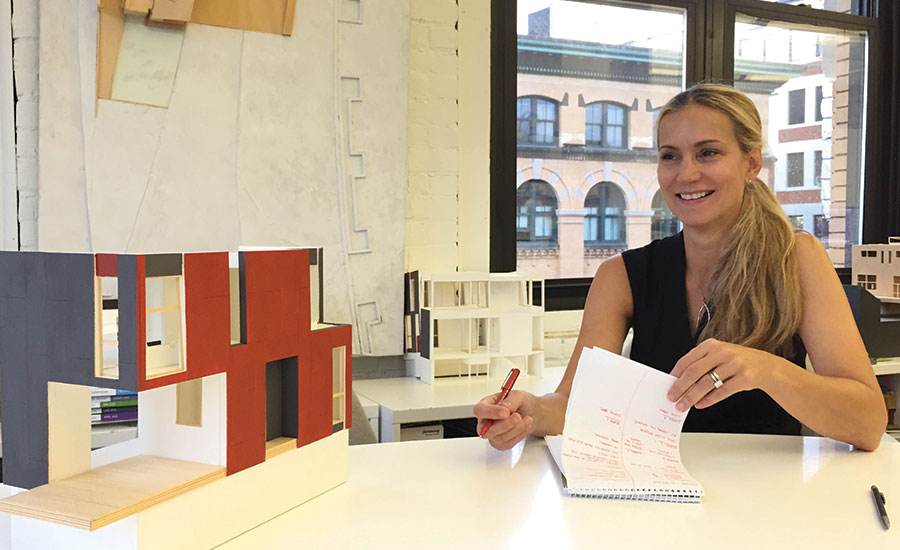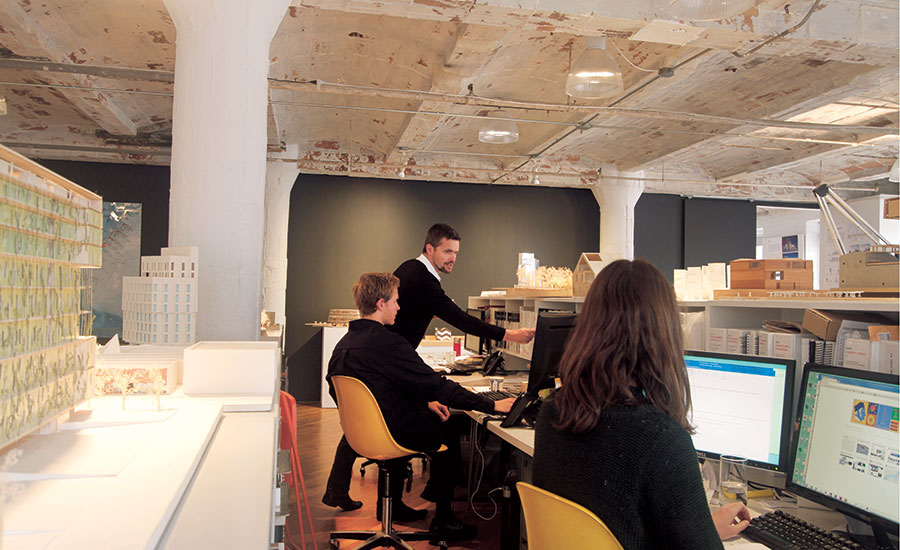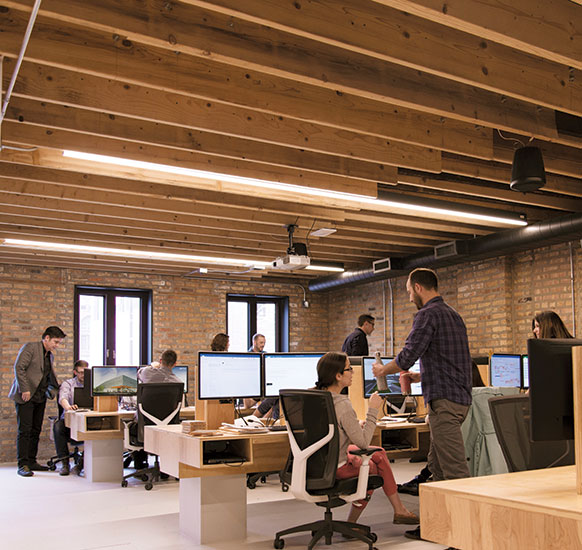The Future of Practice: Small Firms
Practitioners in six firms talk about being hands-on, resourceful, and nimble in order to stay competitive in a fast-evolving field.

Elizabeth Whittaker of Merge Architects in Boston
Photo courtesy Merge Architects

Cade Manning Hayes of DUST, in Tucson, Arizona
Photo courtesy DUST

Jensen Architects on-site in San Francisco
Photo courtesy Jensen Architects

nArchitects in New York
Photo courtesy nARCHITECTS

Digsau in Philadelphia
Photo courtesy Digsau, © Halkin Mason Photography

JGMA (Juan Gabriel Moreno Architects) in Chicago
Photo courtesy JGMA






| DIGSAU | DUST | Jensen Architects | JGMA | MERGE Architects | nArchitects |
|---|---|---|---|---|---|
| Philadelphia | Tucson, Arizona | San Francisco | Chicago and Medellín, Colombia | Boston | New York City |
| Founded in 2007 | Founded in 2007 | Founded in 1994 | Founded in 2010 | Founded in 2003 | Founded in 1999 |
| 17 employees | 2 employees | 24 employees | 22 employees | 16 employees | 10 employees |
Close relationships with clients, value-added service, an emphasis on design quality, a collegial work atmosphere—the appeals of small firms have lured many architects into opening up shop. But once you’ve been in business for a while, what does it really feel like? When asked about how the Philadelphia firm Digsau establishes fees for clients, a tongue-in-cheek response from one of its four cofounders, Jeff Goldstein, captures the flavor of having a small architecture firm today. “We do our best, based on what we’ve learned from past projects,” he says. “Sometimes we get it right, and we’re glad when that happens. But if any of the other firms you’re talking to have cracked the code on this, let me know.”
Conversations with principals from six firms across the country, ranging in size from two to just over 20 employees, revealed uncertainties about how to juggle projects and finances while striving to bring in new, meaningful work. But the unease is tempered by satisfaction with their projects, and a deep commitment to good design and its power to transform lives.
Small architectural firms have always dominated the profession. According to the AIA’s 2016 Firm Survey Report, 77.3 percent of firms have nine or fewer employees, representing roughly one-fifth of all architects and bringing in 15.4 percent of all architectural billings. For firms of 10 to 49 people (17.6 percent of all practices), the figures are 32.3 percent and 33.3 percent respectively. Though the stats on small businesses of all types are sobering—half of them fail after five years, and 70 percent are kaput by year 10—all six of the firms who spoke to RECORD have stuck it out for eight years or longer, and five weathered the Great Recession. So what helped these firms stay in business? And will the circumstances that boosted them in the past continue to do so in the future?
For Digsau and others, engaging in diverse project types kept them afloat during lean times (they launched in pre-recession 2007). “We always wanted to be working in different building sectors,” says Goldstein, “so we weren’t overly vulnerable in any one area when the recession hit, and we’d hope the same would be true in future downturns.”
So what is it that prompts these designers to take a chance and hang out their shingle in the first place? Personal connections are often one factor. Family and friends of employees gave Elizabeth Whittaker’s Boston practice Merge Architects its first townhouse renovations and small retail spaces and cafés when Whittaker opened its doors in 2003. “Through word of mouth, we earned a reputation for delivering high design quality on ridiculously tight budgets, and for using materials in a resourceful, creative way,” she says. Her project mix now includes multifamily housing, large corporate interiors, and university buildings.
Some firms picked up momentum after winning awards or securing a high-profile project. Merge was named a RECORD Design Vanguard in 2014, and then Whittaker herself won a 2015 Emerging Voices award from the Architectural League of New York; she says “things definitely ticked up” afterward. The New York firm nARCHITECTS, also a Design Vanguard—in 2004—had a surge after winning the prestigious Young Architects Program competition the same year to design a seasonal installation at MoMA PS1, an arts space in Queens. Their project, a bamboo canopy, “became a gateway to many things we’re doing now, like Pierscape, our renovation of the old Navy Pier in Chicago with James Corner Field Operations,” says Eric Bunge, firm principal and cofounder with wife and partner Mimi Hoang.
Engaging with community organizations has helped Jensen Architects in San Francisco land such high-profile clients as SFMOMA, for whom they designed a rooftop sculpture garden, and IDEO, which tapped the firm to overhaul its San Francisco offices. Founder Mark Jensen has served on many arts boards and commissions in the Bay Area, as have several of his colleagues. “Our interests as architects led us to participate in these efforts, which enabled us to meet wonderful clients who value design as much as we do,” he says. He and others in the firm also teach at California College of the Arts (CCA), a common way that small-firm practitioners supplement their incomes while expanding their horizons.
For the Chicago firm JGMA (Juan Gabriel Moreno Architects), focusing on a particular client base—underserved communities—led to opportunities outside that realm. “There is such a thirst for high-quality architecture in low-income neighborhoods, and it can lift them up,” says its founder, Juan Gabriel Moreno. After building a new athletic field for Uno Soccer Academy, a high school in a largely Latin neighborhood in southwest Chicago, he got a call from local developer John Buck, who’d been following the project. “Have you ever done a high-rise before?” Buck asked. Moreno told him no. “Good,” Buck said. “I’m going to give you your first one.” Moreno ended up working on schematic design and interiors for Buck’s residential building at 311 Illinois in the River North neighborhood, near the Magnificent Mile.
At the extreme end of small, the two-person firm DUST in Tucson enjoys the freedom to run a practice driven by the master-builder concept. Started by former Texas Tech architecture classmates Cade Manning Hayes and Jesús Edmundo Robles, Jr., the firm has built everything they’ve designed, working closely with local artisans, designers, and craftspeople. The firm’s website showcases just three finished projects—two passive houses and an outdoor pavilion, all in Arizona—along with smaller-scale work such as furniture and public art. “We see ourselves as an arts-driven practice, and we really don’t think about ‘putting business first,’ so to speak,” says Robles. “If we grow at all, we’d want to do it organically, according to where the work takes us.”
All the firms expressed a similar idea of what they hoped would sustain them: projects that are ambitious in scope and program, and make a positive impact on their occupants and community, with clients who value what the architects bring to the table. “We can’t always compete on a fee basis with larger firms,” says Goldstein, “but we feel we can deliver a higher level of design and hands-on service.” He points to the firm’s new residential hall for Swarthmore College—a cluster of three slate-clad volumes—as a sort of platonic ideal: done for a repeat client who emphasizes sustainability, the project approaches net zero energy use and successfully mediates an important junction near the campus baseball field and a group of historical buildings. “These are the sorts of projects—and clients—you dream about,” he says.
That said, he and his cohorts know that clients typically tap larger firms for larger projects. Yet small firms are hesitant about the trade-offs of growing bigger and ceding control. “Most of our work is local, and we prefer it that way,” says Jensen. “Our leadership is deeply involved in every project. We’re a very hands-on practice; for a long time, we had just nine or 10 employees. Now we’re at 24 people because of our workload, and I feel as if that’s our fighting weight.” Goldstein believes there’s potential in teaming up with a firm of a similar size and complementary skill sets to pursue projects that larger firms typically win. “Convincing clients it’s cost-effective might be a tough sell, but I’d like to try it out,” he says.
There’s no question that today’s business climate for small firms is far more complex and challenging than in years past. “I’m bracing myself for the next recession,” Whittaker admits. “Housing will take a hit first, and that represents a big chunk of what we’re doing. Even though we’re busy, it all feels extremely fragile.” Jensen says technological innovations have caused a major shift in client expectations. “Tools for drawing, modeling, and communication have proliferated and improved, so clients expect the same level of service from firms of any size,” he says. “That means we have to invest in technology on a regular basis just to remain competitive.”
And money remains a big problem. “Collecting fees has gotten tougher and tougher,” says Moreno. “It’s hard, especially as a young firm, to get enough revolving credit to keep bills paid. Architects have somehow become the bankers for projects. We do all the work in advance, incur expenses of our own, and then need to chase down checks once it’s over. It’s not how I want to be spending my time.” These firms also do too much work for too little money. “Conceptual designs were not a separate deliverable when we started our firm,” says Bunge. “Now we do them for every project and fees don’t accurately reflect the extra work.” Whittaker is pushing back more often on scope creep with clients. “Early on, I lost my shirt on some projects,” she admits. “I can’t do that anymore.” Her fees typically range from 5.5 to 11 percent depending on the program and project type; they can go as high as 15 to 18 percent for smaller projects and residential work. Like people at many firms, she’s moved away from hourly billing toward a fixed-price-plus-expenses model. “With hourly billing, I found that clients would nickel-and-dime every invoice, because they’d question how long certain tasks should take,” she says. “It was exhausting.”
Though they know they can’t control the economy or where their next clients might come from, these designers also know architectural practice must continue to evolve to remain viable. Getting involved in projects at the earliest planning stages is a critical step. “It used to be that landscape architects got hired last on a project, and now they’re often hired first, because we’re paying more attention to how buildings and land use must work together,” says Jensen. “But if we’re brought on at the end and told ‘put your building here,’ that limits our effectiveness at coming up with creative ways to meet broader program goals.”
Maintaining racial and gender diversity on their staffs is also very much on their minds. “We should reflect the society we live in,” says Bunge. “We have to understand why these inequalities exist in our profession at large, and how they can be rectified.” He also believes engagement in progressive politics is an underappreciated opportunity for small firms, which often work locally and can be more agile than large ones. “The conversations around memorials and historical attractions are shifting to include people whose voices were once left out,” he says. The state of New York recently tapped nARCHITECTS to design the Equal Rights Heritage Center in Auburn, New York, where Harriet Tubman lived for the last 15 years of her life. Originally envisioned as a simple welcome center, the program has grown to encompass exhibitions about the Underground Railroad, abolition, women’s suffrage, and LGBTQ rights, touting the state’s and Auburn’s roles as leaders in the social justice movement.
Perhaps the most important survival skill these small-firm leaders have to carry them into the future is a steadfast devotion to their calling, despite its many obstacles and unknowns. “Running a small firm has always been tough, and it’s true that today it’s tougher than ever and harder to know what’s around the corner,” says Jensen. “But we have a lot of great work with great clients who appreciate what we bring to them. And I’m still happy to come to work every day. As long as that’s true, I’ll keep on doing this.”












